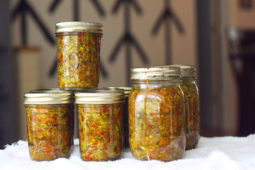Brewed: The Basics of Home Brewing Beer
![Credit: David [manmadediy.com] Brewed Homebrewed Beer Logo](https://s3.amazonaws.com/manmadediy-uploads-production/photos/24126/Brewed%20Logo%201_large.jpg?1416814408) Brewing beer in my closet has been a recent hobby of mine, and like most my hobbies it has expanded into a bit of an obsession. Although I’m no expert on the subject, I’ve made enough mistakes to serve as a useful warning to others. So, in this four part series we’ll walk through what it takes to make a handmade batch of frothy, fermented goodness.
Brewing beer in my closet has been a recent hobby of mine, and like most my hobbies it has expanded into a bit of an obsession. Although I’m no expert on the subject, I’ve made enough mistakes to serve as a useful warning to others. So, in this four part series we’ll walk through what it takes to make a handmade batch of frothy, fermented goodness.![credit: David Skinner [manmadediy.com] Milk Chocolate Stout Homebrew](https://s3.amazonaws.com/manmadediy-uploads-production/photos/24127/Brewed%20Logo%203_large.jpg?1416814753) 1. A Background On Beer
1. A Background On Beer
Beer. Nature’s nectar, the life of the party, and an excuse for why my middle keeps expanding. Brewed by fermenting the sugar from cereal grains and yeast, the first batch of artisanal ale created about 7,000 years ago was likely an accident (Read about it on Wikipedia). Since then beer in some form became as common as water, and at many points in history it was safer to drink thanks to the alcohol content. Outside of monasteries, large-scale production of beer didn’t really happen until the 19th century industrialization. It is now a multi-billion dollar industry with many large-scale breweries churning out millions of barrels a year. With so many varieties clogging the shelves, it’s easy to get lost in the subject. So that is exactly where we’ll start.
![credit: David Skinner [manmadediy.com] Homebrewing All Grain](https://s3.amazonaws.com/manmadediy-uploads-production/photos/24130/Brewed%20Grain_large.jpg?1416815468)
2. Homebrew Basics
At the very basic level, brewed beer is turning water into a fermented pick-me-up by boiling cereal grains to release sugars, throwing in hops for flavor and aroma, and then adding yeast to convert the sugars into alcohol and carbonation. Flavors and textures are dependent on the ingredients, boil times, and additives. Using this (kinda) simple process, the brew becomes beer. The concept of homebrew is an increasingly popular as equipment and ingredients become more accessible, and caught my attention a few years ago when a friend started making his own beers. Living on the West Coast exposes me to some of the very best craft brews in the country, and it was only a matter of time before I tried to make my own.
![credit: Northern Brewer [www.northernbrewer.com] Northern Brewer All Grain Brew In A Bag (BIAB)](https://s3.amazonaws.com/manmadediy-uploads-production/photos/24129/brew_in_a_bag_equipment_kit_large.jpg?1416814940)
3. How to get started
The steps for a first batch start with a visit to the local homebrew store. Most stores have a starter kit with everything but the kettle to make 2-3 gallons of beer. The best way to go is with a Brew-In-A-Bag (BIAB) kit. Talk to the local folks about a recipe that will produce your chosen beer. The all grain method is a good mix between ease and control over the process. All grain allows the entire process to happen in a single pot, without the need for complicated steps, but it also requires enough input to make it interesting. A word of advice: keep it simple. There’s plenty of time to experiment with additives and flair. With the kit, a few pounds of grain, hops and yeast it’s time to prep for brew day.
This is the first of four parts of the Brewed series. Come back next week to get prepped for the brew day, and see a few lessons learned on my first attempt at brewing: The Dirty Red.








